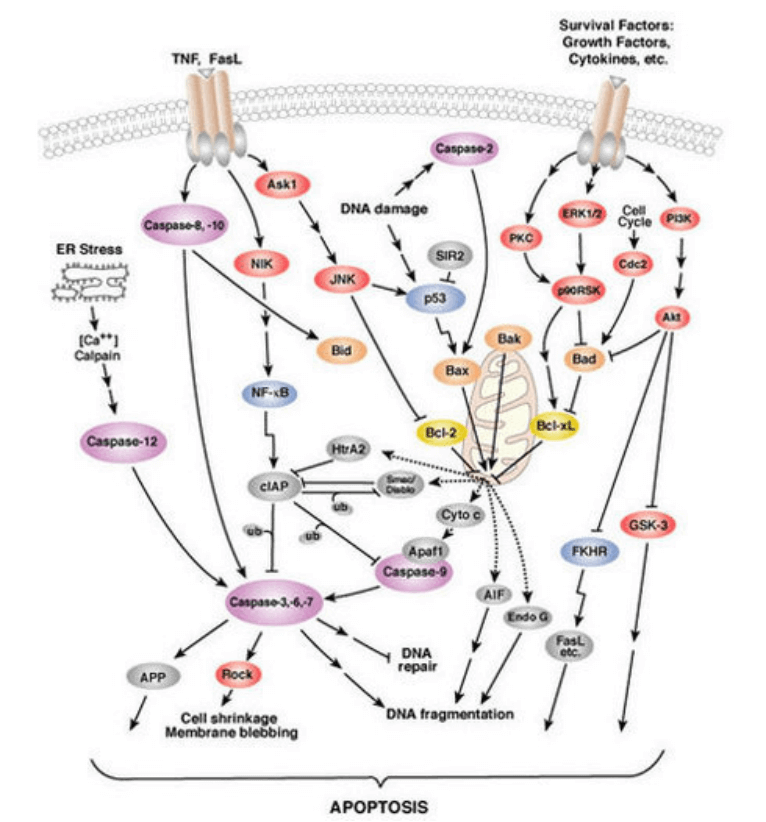Introduction to necroptosis signaling pathway
Based on Luminex technology platform, Creative Proteomics provides analysis services for key targets of necroptosis signaling pathway.

Necroptosis, a recently discovered form of programmed cell death, is a cell death mechanism that has necrosis-like morphological characteristics. Necroptosis activation relies on the receptor-interacting protein (RIP) homology interaction motif (RHIM). A variety of RHIM-containing proteins transduce necroptotic signals from the cell trigger to the cell death mediators RIP3 and mixed lineage kinase domain-like protein (MLKL). RIP1 plays a particularly important and complex role in necroptotic cell death regulation ranging from cell death activation to inhibition, and these functions are often cell type and context dependent. Increasing evidence suggests that necroptosis plays an important role in the pathogenesis of neurodegenerative diseases. Moreover, small molecules such as necrostatin-1 are thought inhibit necroptotic signaling pathway. Understanding the precise mechanisms underlying necroptosis and its interactions with other cell death pathways in neurodegenerative diseases could provide significant therapeutic insights.
Necroptosis can be widely stimulated by tumor necrosis factor (TNF), other members of the TNF death ligand family (Fas and TNF-related apoptosis-inducing ligand (TRAIL)), interferons, Toll-like receptors (TLRs) signaling and viral infection via the DNA sensor DNAdependent activator of interferon regulatory factor (DAI). Various upstream signaling pathways share the common terminal mechanism executed by mixed lineage kinase domain-like proteins.
Blocking necroptotic pathways with synthetic inhibitors or genetic manipulation mitigates neurodegenerative disease in vitro and in vivo, which suggests a promising therapeutic strategy for neurodegenerative disease.
Our detectable targets:
| ROCK | GSK-3 | NIK | Bid | Ask-1 | PKC |
| Cdc2 | ATG4 | JNK | MYD88 | Rac1 | TLR4 |
| ATG16 | WIPi2 | LC3I | PROLC3 | ULK | FIP200 |
| VPS15 | VPS34 | UYRAG | NF-κB | RIG-1 | TRAF3 |
| GAS | IRF9 | AMBRA1 | p38 | RIP1 | TRAF5 |
| Histone-H3 | IRF5 | MEK3 | p38MAPK | SH2 | TRAF6 |
| IPS-1 | ISGF3 | MSK2 | PI3K | TBK1 | Vav |
| IRAK1 | ISRE | mTOR | PKR | TLR3 |
Technology platform:
We provide Luminex technology for necroptosis signaling pathway analysis.
Luminex technology is a multifunctional liquid phase analysis platform developed on the basis of colored microspheres, laser technology, applied fluidics and high-speed digital signal processing technology. The core is to encode polypropylene microspheres or magnetic microspheres with fluorescent dyes. By adjusting the different ratios of the two fluorescent dyes, up to 100 microspheres with different fluorescence spectra can be obtained. Antigen-antibody, enzyme-substrate, ligand-receptor binding reactions and nucleic acid hybridization reactions are performed on microspheres with different fluorescence encoding. Qualitative and quantitative analysis by laser detection of microsphere coding and reporter fluorescence separately.
Necroptosis is involved in many pathological processes, such as ischemia-reperfusion injury in the heart,11 brain,4 and in injury-induced inflammatory diseases. Necroptosis reportedly plays a critical role in the pathogenesis of several neurodegenerative diseases.
In addition to Luminex Multiplex Assay, Enzyme-linked immunosorbent assay (ELISA), Flow cytometry (FACS analysis) technology can also be provided to meet other customer needs.
Advantages of necroptosis signaling pathway detection:
- High sensitivity: The surface area of the microspheres is large, and 100,000 probes can be fixed on each microsphere, which ensures the maximum binding with the target molecules in the sample and improves the detection sensitivity. The lowest detection concentration can reach 0.1pg/mL.
- Strong specificity: Can read the fluorescent signal on a single microsphere, and automatically distinguish between bound and unbound microspheres.
- High accuracy: Without washing, the fluorescence intensity of the reporter molecule on the microsphere is proportional to the bound molecule to be detected. Because the detection range of the Luminex detection platform is large, it does not need to be diluted like ELISA detection, which further reduces errors.

Application of our service:
- To study the regulation mechanism of necroptosis signal pathway in disease
- To study the effect of each virus on necroptosis signaling pathway
- To study the effects of drugs or therapies on necroptosis signaling pathways
Creative Proteomics has developed a signal pathway target detection platform. We are not limited to providing necroptosis signal path detection services, but can also provide other signal path detection services. If you want to detect other targets, please contact us and we will customize the service for you. Look forward to working with you.
References:
- Lalaoui N, Lindqvist LM, et al. The molecular relationships between apoptosis, autophagy and necroptosis. Semin Cell Dev Biol, 2015, 39: 63-69.
- Koshinuma S, Miyamae M, et al. Combination of necroptosis and apoptosis inhibition enhances cardioprotection against myocardial ischemia-reperfusion injury. J Anesth, 2014, 28: 235-241.



